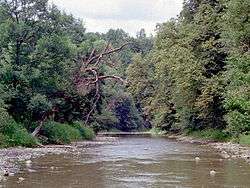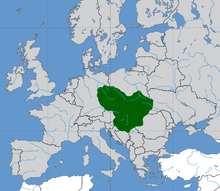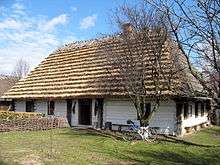Wisłok
Wisłok is a river in south-eastern Poland, a tributary of the San River, with a length of 220 kilometres and a basin area of 3,538 km2 (all in Poland).[1] The root of the name Vis-lok is Indo-European or pre-Indo-European.
| Wisłok | |
|---|---|
 | |
| Location | |
| Country | Poland |
| Physical characteristics | |
| Source | |
| • location | Carpathian Mountains |
| Mouth | |
• location | San |
• coordinates | 50°12′21″N 22°32′0″E |
| Length | 220 km (140 mi) |
| Basin size | 3,538 km2 (1,366 sq mi) |
| Discharge | |
| • average | 24.5 m3/s (870 cu ft/s) |
| Basin features | |
| Progression | San→ Vistula→ Baltic Sea |
The first metal bridges on highways were built in Galicia. They were bridges on the Wisłok river in Rzeszów (1877) and Raba in Książnica (1877). The construction of the first latticework metal bridges in Poland's territories.[2]
History
There is no data on the settlements in the early Iron period when an old trade route crossed the region along Wisłok River Valley. The Wisłok valley must have been an important trade route and human settlement axis as early as 9th or 10th century. The region subsequently became part of the Great Moravian state. Upon the invasion of the Hungarian tribes into the heart of the Great Moravian Empire around 899, the Lendians of the area declared their allegiance to Hungarian Empire. The region then became a site of contention between Poland, Kievan Rus and Hungary starting in at least the 9th century. This area was mentioned for the first time in 981 (by Nestor), when Volodymyr the Great of Kievan Rus took the area over on the way into Poland. In 1018 it returned to Poland, 1031 back to Rus, in 1340 Casimir III of Poland recovered it[3]

In historical records the river was first mentioned in 1372. During 966 – 1018, 1340–1772 (Ruthenian Voivodeship) and during 1918 – 1939 the region was a part of Poland.
Actually the intensive development of human settlements in theregion took place during 13th–15th centuries. The settlements were located according to the German Law within an area flanked by Wisłok and Wisłoka rivers.[4] Germans settled in the territory of the Kingdom of Poland (territory of present-day Województwo podkarpackie) from the 14th to 15th centuries (see Ostsiedlung), mostly after the region returned to Polish sphere of influence in 1340, when Casimir III of Poland took the Czerwień towns. There were probably some isolated settlers in the area of Krosno, Sanok, Łańcut, Biecz and Rzeszów earlier. The Germans were usually attracted by kings seeking specialists in various trades, such as craftsmen and miners. They usually settled in newer market and mining settlements. The main settlement areas were in the vicinity of Krosno and some language islands in the Pits and the Rzeszów regions. The settlers in the Pits region were known as Uplander Sachsen.[5] Until approximately the 15th century, the ruling classes of most cities in present-day Beskidian Piedmont consisted almost exclusively of Germans.

While during 1772–1918 it belonged to Austrian empire, later Austrian-Hungarian empire when double monarchy was introduced in Austria. This part of Poland was controlled by Austria for almost 120 years. At that time the area (including west and east of Subcarpathian Voivodeship) was known as Galicia.
The line of the river Dunajec and that of the San, both in West Galicia, marked the two successive stages in the break-through battle which initiated the Austro-German offensive of 1915 on the eastern front. An attempt to stand on the line of the Wisłok river and the Łupków Pass failed before renewed Austro-German attacks on 8 May 1915. Wisłok Valley was one of the strategically important Carpathian rivers bitterly contested in battles on the Eastern Front of World War I during the winter of 1914/1915.[7]
Geography
Towns and townships:
The main tributaries:
See also
- Rivers of Poland
References
- Inline:
- Statistical Yearbook of the Republic of Poland 2017, Statistics Poland, p. 85-86
- Janusz Jankowski. Mosty w Polsce o mostowcy Polscy. 1973. p. 346
- Prof. Adam Fastnacht – Slownik Historyczno-Geograficzny Ziemi Sanockiej w Sredniowieczu, Kraków 2002, ISBN 83-88385-14-3
- Acta Palaeobotanica. 1988. p. 25-29 op. cit. Żaki, Kunysz
- Głuchoniemcy (Walddeutsche) [in:] Geographisches Ortsnamenlexikon des Polnischen Königreiches. Band II. S. 612 Warszawa. 1889 (Eine Bilddatenbank zur polnischen Geschichte)
- Franciszek Kotula. Pochodzenie domów przysłupowych w Rzeszowskiem. "Kwartalnik Historii Kultury Materialnej" Jahr. V., Nr. 3/4, 1957, S. 557
-

The Pursuit and Battles at Sanok and Rzeszów (May 6–11).—After his severe defeat, Radko Dimitriev's plan was to hold the Lupków Pass with his left wing, and, supported upon this, to bring the pursuit to a stand on the line Nowotaniec–Besko-right bank of the Wislok, where there were positions favoured by the lay of the ground, and then, between the Vistula and the Wislok, on the line Wielopole-Rzeszów–Malec. Here he proposed to reconstitute his units, which had fallen into great disorder, and to strengthen them by bringing up reserves. Troops were sent to him from other fronts, and by the 8th he could again dispose of 18 inf. divs., 5 ca y. divs. and 5 Reichswehr bdes. The orders were that the offensive was to be continued with all possible vigour. Mackensen's army was to push forward over the stretch of the Wislok between Besko and Frysztak on Mrzyglód and Tyczyn, and the Archduke Joseph Ferdinand on Rzeszów, while Boroevic was to roll up Brussilov's VIII. Russian Army in the direction of Sanok. Bohm's II. Austrian Army was to join up corps by corps from the left wing in proportion to the progress of the attack. ...
Literature
- Prof. Adam Fastnacht. Slownik Historyczno-Geograficzny Ziemi Sanockiej w Średniowieczu (Historic-Geographic Dictionary of the Sanok District in the Middle Ages), Kraków, 2002, ISBN 83-88385-14-3.